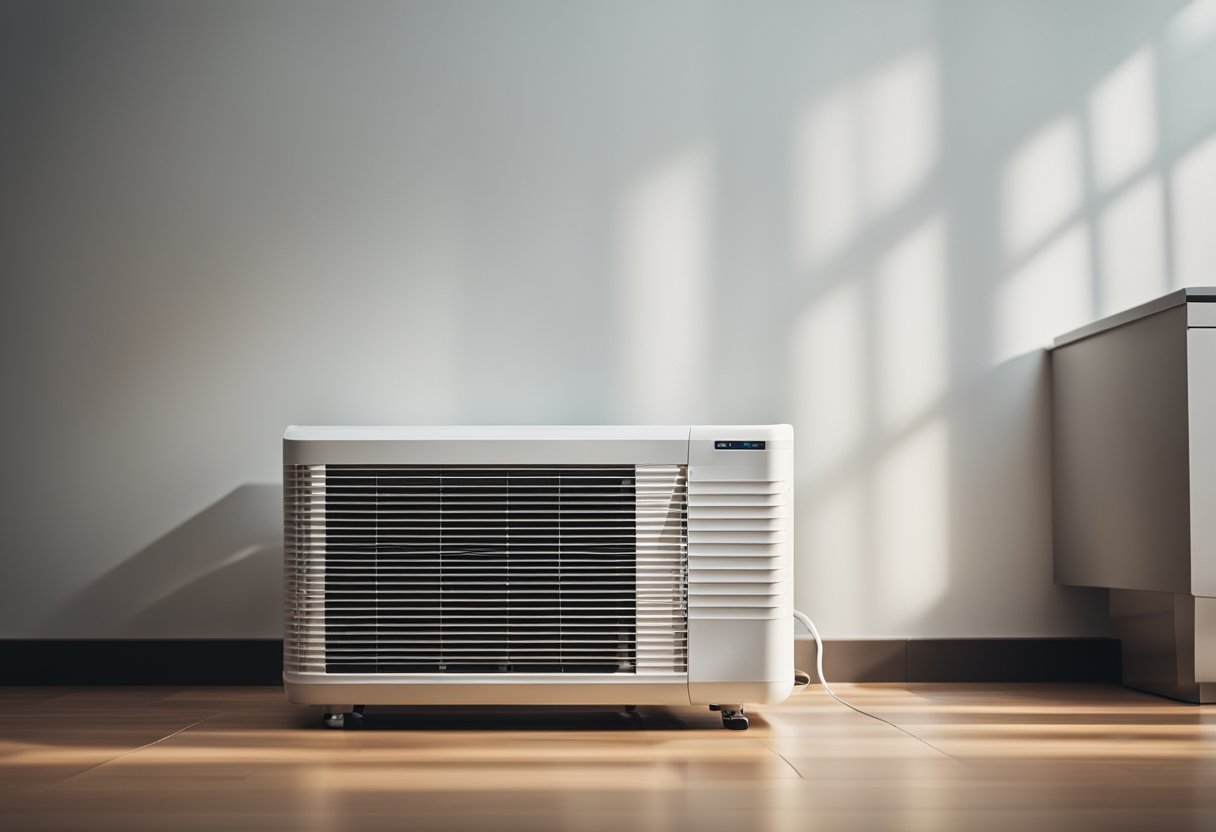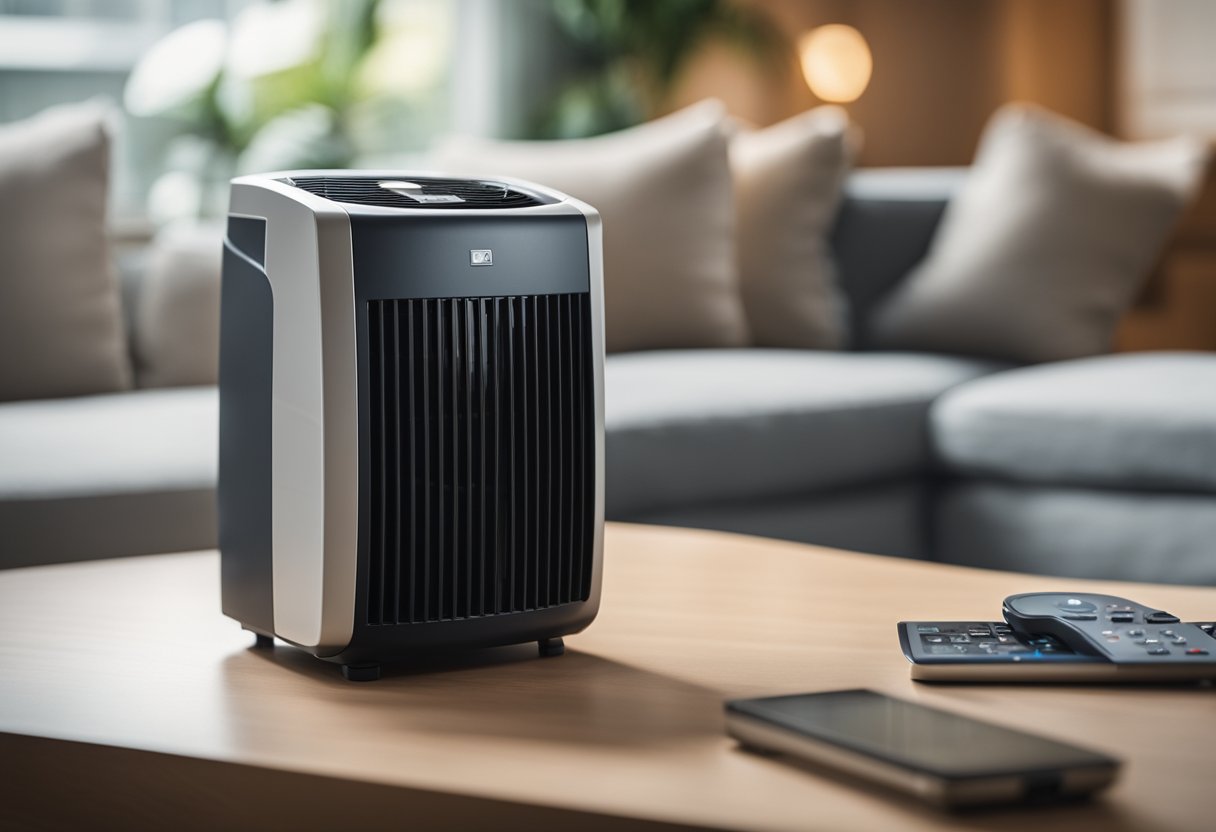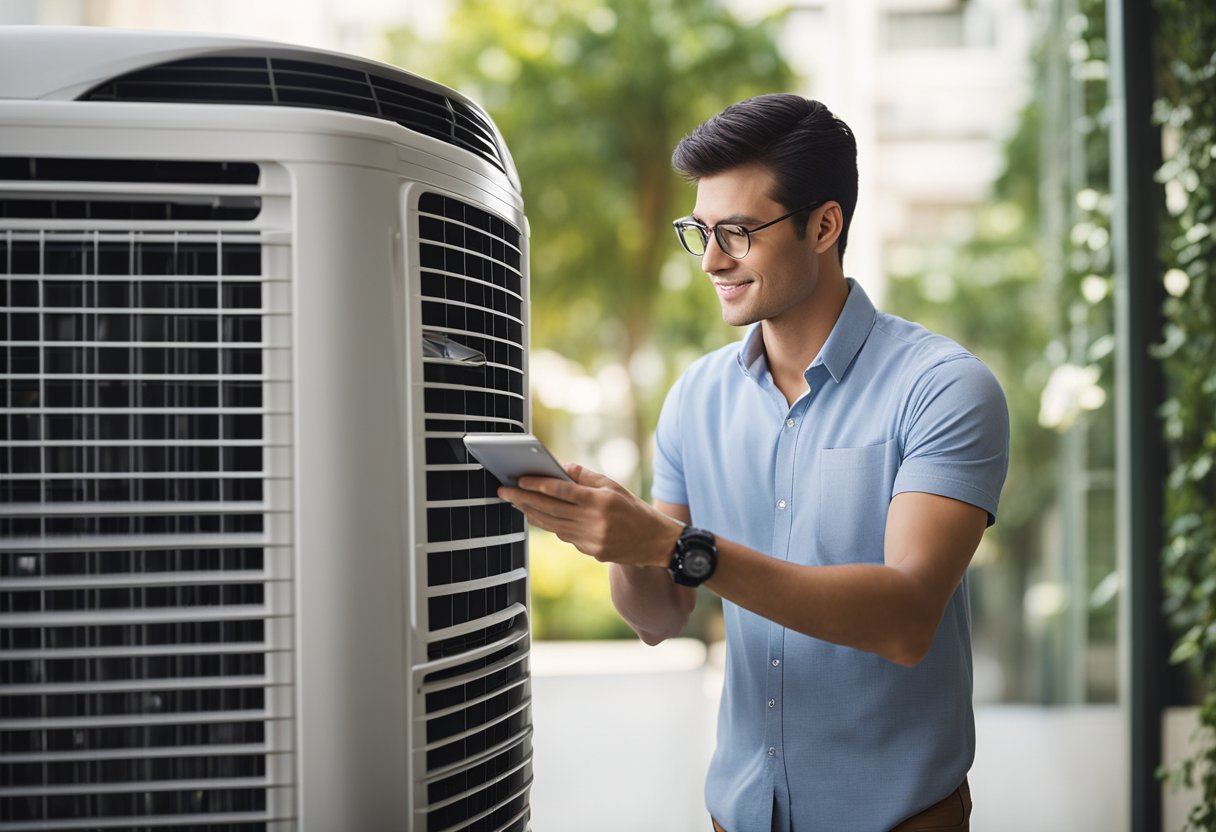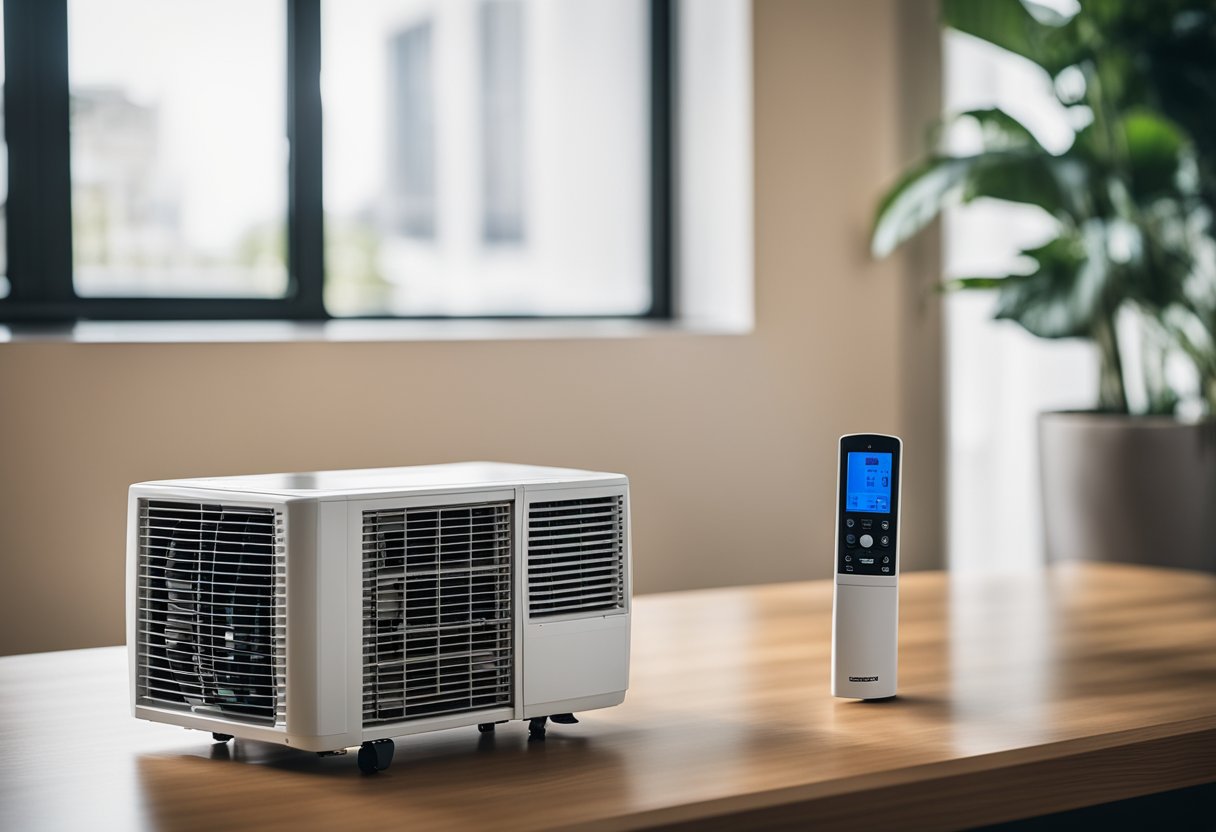Air conditioners are a common appliance in most households, especially during the summer season. They help regulate the temperature and humidity levels in a room, making it comfortable to live and work in. There are different types of air conditioners available in the market, including portable air conditioners, also known as portable AC units or aircon.
Portable air conditioners are compact and easy to move around, making them a popular choice for people who live in apartments or small houses. They work by taking in warm air from the room, cooling it down, and then releasing it back into the room. Unlike central air conditioning units, portable ACs do not require any installation, making them a convenient option for renters or people who do not want to make any permanent changes to their living space.
One of the key advantages of portable air conditioners is their flexibility. They can be moved from room to room, providing cooling comfort wherever it is needed. Additionally, they are generally more energy-efficient than central air conditioning units, which can save homeowners money on their energy bills. However, it is important to note that portable AC units are not as powerful as central air conditioning units and may not be suitable for large spaces.
Key Takeaways
- Portable air conditioners are a convenient and flexible option for regulating temperature and humidity levels in small spaces.
- They are generally more energy-efficient than central air conditioning units, providing cost savings on energy bills.
- While portable AC units are not as powerful as central air conditioning units, they are a great option for people who need cooling comfort in specific areas of their home or office.
Understanding Air Conditioners
Types of Air Conditioners
There are two main types of air conditioners: central air conditioners and room air conditioners. Central air conditioners are designed to cool the entire house, while room air conditioners are designed to cool a single room or a small area. Room air conditioners come in two types: window air conditioners and portable air conditioners.
Window air conditioners are installed in a window and are designed to cool a single room. They are relatively inexpensive and easy to install, but they can be noisy and may not be suitable for larger rooms.
Portable air conditioners are free-standing units that can be moved from room to room. They are easy to install and can be used in rooms where a window air conditioner cannot be installed. Portable air conditioners are also quieter than window air conditioners and can be used to cool larger rooms.
How Air Conditioners Work
Air conditioners work by removing heat from the air in a room and transferring it outside. This is done through a process that involves three main components: a compressor, a condenser, and an evaporator.
The compressor compresses the refrigerant, which is then cooled in the condenser. The cooled refrigerant then flows through the evaporator, where it absorbs heat from the air in the room. The cooled air is then blown back into the room, while the heat is transferred outside.
BTU and Cooling Capacity
BTU (British Thermal Unit) is a measure of the cooling capacity of an air conditioner. The higher the BTU rating, the more cooling capacity the air conditioner has. A portable air conditioner with a BTU rating of 8,000 can cool a room up to 350 square feet, while a unit with a BTU rating of 14,000 can cool a room up to 700 square feet.
It is important to choose an air conditioner with the appropriate BTU rating for the size of the room you want to cool. An air conditioner that is too small will not be able to cool the room effectively, while an air conditioner that is too large will waste energy and may not dehumidify the room properly.
Features of Portable Air Conditioners
Portable air conditioners are popular for their mobility and versatility. They are designed to cool a small or large space, depending on the unit’s cooling capacity. In addition to cooling, portable air conditioners offer several other features that make them a popular choice for homeowners. Here are some of the key features of portable air conditioners:
Remote Control Functionality
Most portable air conditioners come with a remote control that allows you to adjust the temperature, fan speed, and other settings from across the room. This feature is especially useful if you want to adjust the temperature while you’re sitting on the couch or in bed. With the remote control, you can change the settings without having to get up and walk to the unit.
Built-in Humidifier and Air Purifier
Some portable air conditioners come with a built-in humidifier and air purifier. These features can help improve the air quality in your home by removing allergens, dust, and other particles from the air. The built-in humidifier can also help add moisture to the air, which can be beneficial during the dry winter months.
Heater Integration
In addition to cooling, some portable air conditioners also have a heater integration feature. This means that you can use the unit as a heater during the colder months. This feature can be especially useful if you live in an area with fluctuating temperatures, where you need both heating and cooling throughout the year.
Smart Connectivity Features
Many portable air conditioners now come with smart connectivity features that allow you to control the unit with your smartphone or with voice commands using Google Assistant or Amazon Alexa. With the smartphone app, you can adjust the temperature, fan speed, and other settings from anywhere, even when you’re not at home. This feature is especially useful if you want to turn on the air conditioner before you get home, so your home is cool and comfortable when you arrive.
Advantages of Portable AC Units
Portable air conditioners are convenient cooling solutions that come with a range of benefits. In this section, we’ll explore some of the advantages of using a portable AC unit.
Mobility and Room-to-Room Use
One of the primary benefits of portable AC units is their mobility. Unlike traditional AC units, portable AC units are designed to be easily moved from room to room. They come with casters or wheels that allow them to be easily rolled from one area to another. This makes them ideal for use in homes or offices where cooling needs may change throughout the day. With a portable AC unit, you can keep cool wherever you go without having to invest in multiple AC units.
Ease of Installation and Venting
Another advantage of portable AC units is their ease of installation and venting. Unlike window AC units, which require complex installation procedures, portable AC units can be set up in a matter of minutes. All you need to do is plug them in and connect the vent hose to the window. This makes them ideal for renters or people who don’t want to invest in permanent cooling solutions.
Energy Efficiency
Portable AC units are also energy-efficient. They are designed to cool small to medium-sized rooms, which means they use less energy than traditional AC units that are designed to cool entire homes. This makes them ideal for people who want to save money on their energy bills while still enjoying the benefits of air conditioning.
In summary, portable AC units offer a range of benefits, including mobility, ease of installation and venting, and energy efficiency. With their convenient design and cooling capabilities, they are an excellent choice for anyone who wants to stay cool and comfortable during the hot summer months.
Selecting the Best Portable Air Conditioner
When considering a portable air conditioner, there are several factors to keep in mind to ensure that you select the best unit for your needs. In this section, we will discuss some of the key considerations when selecting a portable air conditioner.
Assessing Room Size and Unit Capacity
One of the most important factors to consider when selecting a portable air conditioner is the size of the room you wish to cool. Portable air conditioners are typically rated by their British Thermal Unit (BTU) output, which indicates the amount of cooling power the unit can provide. As a general rule, the larger the room, the higher the BTU rating you will need.
To determine the appropriate BTU rating for your room, you can use a simple formula: multiply the square footage of the room by 20. For example, a 200 square foot room would require a unit with a BTU rating of at least 4,000 (200 x 20).
Comparing Single-Hose and Dual-Hose Models
Portable air conditioners come in two main types: single-hose and dual-hose models. Single-hose models are typically less expensive and easier to install, but they are also less efficient. Dual-hose models, on the other hand, are more efficient and can cool a room more quickly, but they are also more expensive and can be more difficult to install.
When selecting a portable air conditioner, it is important to consider which type of unit will best meet your needs and budget.
Evaluating Performance and Quiet Operation
In addition to assessing room size and choosing between single-hose and dual-hose models, it is also important to consider the performance and noise level of a portable air conditioner. Look for units with adjustable fan speeds and temperature settings, as well as models with a dehumidifying function.
It is also important to consider the noise level of a unit, especially if you plan to use it in a bedroom or other quiet space. Look for models with a low decibel rating and a “quiet” or “sleep” mode.
Testing for the Lowest Temperature Settings
Finally, when selecting a portable air conditioner, it is important to test the unit’s lowest temperature settings. Some models may not be able to cool a room to the desired temperature, especially in hot and humid climates. Look for units with a low temperature setting and a high BTU rating to ensure that you can keep your room cool and comfortable even on the hottest days.
By considering these factors and selecting a high-quality portable air conditioner, you can enjoy cool, comfortable air in any room of your home or office.
Maintaining Your Portable Air Conditioner
Maintaining your portable air conditioner is essential to keep it running efficiently and prolong its lifespan. This section will cover the basics of maintaining your portable air conditioner, including regular cleaning and filter replacement, dealing with moisture and warm air, and troubleshooting common issues.
Regular Cleaning and Filter Replacement
Regular cleaning and filter replacement are crucial to ensure that your portable air conditioner is working correctly. To clean your portable air conditioner, you will need common household items and tools, such as warm water, mild detergent, or a DIY home cleaning solution, and a non-abrasive cloth or a soft rag.
Cleaning the filter is an essential part of maintaining your portable air conditioner. A dirty filter can cause the air conditioner to work harder and less efficiently, resulting in higher energy bills. To clean the filter, remove it from the unit and rinse it under warm water. Allow it to air dry completely before reinserting it into the unit.
Dealing with Moisture and Warm Air
Moisture and warm air can be problematic for portable air conditioners. To prevent moisture buildup, make sure the unit is installed correctly and is level. If the unit is not level, water can accumulate inside the unit and cause damage.
To deal with warm air, make sure the unit is properly sized for the room it is cooling. A unit that is too small for the room will have to work harder and less efficiently, resulting in warm air blowing out of the unit.
Troubleshooting Common Issues
If your portable air conditioner is not working correctly, there are a few common issues you can troubleshoot. If the unit is not turning on, make sure it is plugged in and the outlet is working correctly. If the unit is making strange noises, check for loose parts or debris inside the unit. If the unit is not cooling correctly, make sure the filter is clean and the unit is not too small for the room it is cooling.
In conclusion, maintaining your portable air conditioner is essential to keep it running efficiently and prolong its lifespan. Regular cleaning and filter replacement, dealing with moisture and warm air, and troubleshooting common issues are all essential parts of maintaining your portable air conditioner.
Innovations and Trends in Portable AC Technology
Portable air conditioners have come a long way in recent years, with new developments and innovations making them more efficient and user-friendly than ever before. This section will explore the recent developments in portable AC units, as well as the future outlook and smart innovations that are set to revolutionize the industry.
Recent Developments in Portable AC Units
One of the most significant recent developments in portable AC units is the LG LP1419IVSM, which uses inverter technology to provide efficient cooling without consuming excessive energy. This technology adjusts the compressor speed to match the cooling needs of the room, resulting in significant energy savings. The LG LP1419IVSM is also equipped with a smart Wi-Fi feature, allowing users to control the unit from their smartphone app.
Another popular portable AC unit is the Whynter Elite ARC-122DS, which features a dual-hose design that allows for more efficient cooling. This unit also has a dehumidifying function, making it ideal for use in humid climates. The Whynter Elite ARC-122DS is also very quiet, making it perfect for use in bedrooms or other areas where noise is a concern.
Future Outlook and Smart Innovations
Looking to the future, smart innovations are set to revolutionize the portable AC industry. One of the most exciting developments is the integration of smart home technology, allowing users to control their AC units with voice commands or through their smartphone app. This will make it easier than ever to adjust the temperature and settings of a portable AC unit, without having to physically interact with the device.
Another innovation that is set to change the industry is the use of eco-friendly refrigerants, which are less harmful to the environment than traditional refrigerants. This will help to reduce the carbon footprint of portable AC units, making them a more sustainable option for cooling homes and other spaces.
In conclusion, portable AC technology is constantly evolving, with new developments and innovations making these units more efficient and user-friendly than ever before. With the integration of smart home technology and eco-friendly refrigerants, the future of portable AC units looks bright.
Cost and Value Considerations
Analyzing Initial Purchase Price
When it comes to purchasing an air conditioning system, the initial purchase price is often one of the most important considerations. Portable air conditioners (PACs) are generally more affordable than central air conditioning systems, but they can be more expensive than window units. However, it’s important to remember that the initial purchase price is just one aspect of the overall cost and value of an air conditioning system.
Understanding Long-Term Value
While the initial purchase price of an air conditioning system is important, it’s also important to consider the long-term value of the system. This includes factors such as energy efficiency, maintenance costs, and lifespan. PACs are generally less energy efficient than other cooling systems, such as evaporative coolers or box fans, but they do offer more convenience and flexibility in terms of placement and portability.
Comparing Portable ACs to Other Cooling Systems
When comparing PACs to other cooling systems, it’s important to consider the specific needs and preferences of the user. For example, if energy efficiency is a top priority, an evaporative cooler may be a better choice than a PAC. However, if portability and convenience are more important, a PAC may be the best option.
In terms of cost and value, PACs can be a good choice for those who need a portable and flexible cooling option, but they may not be the most cost-effective or energy-efficient option in the long run. It’s important to carefully consider all factors and do research before making a final decision on which type of air conditioning system to purchase.
Accessories and Additional Components
When it comes to portable air conditioners, there are a variety of accessories and additional components available to enhance their functionality and convenience. Below are some of the most common accessories that can be used to improve the performance and user experience of a portable air conditioner.
Extra Venting Kits and Window Seals
One of the most important aspects of using a portable air conditioner is ensuring proper ventilation. In some cases, the included venting kit may not be sufficient for your needs, especially if you need to vent the unit through a non-standard window or into a different room. Fortunately, there are a variety of extra venting kits and window seals available that can help you achieve optimal ventilation. These kits typically include additional hoses, adapters, and seals that can be used to connect the unit to a wider range of window sizes and shapes.
Programmable Timers and Remote Controls
Another useful accessory for portable air conditioners is a programmable timer or remote control. These devices can help you automate and control the operation of your unit, making it easier to maintain a comfortable temperature and conserve energy. A programmable timer can be set to turn the unit on or off at specific times of the day, while a remote control allows you to adjust the temperature, fan speed, and other settings from across the room.
Replacement Filters and Additional Wheels
Finally, it’s important to keep your portable air conditioner clean and well-maintained to ensure optimal performance and longevity. Replacement filters can be used to keep the air clean and free of dust and other particles, while additional wheels can make it easier to move the unit from room to room. Additionally, replacement parts such as hoses and adapters can be used to replace damaged or worn components, helping to extend the life of your portable air conditioner.
In summary, there are a variety of accessories and additional components available that can help you get the most out of your portable air conditioner. Whether you need extra venting options, programmable timers, or replacement parts, there are plenty of options available to suit your needs.
Frequently Asked Questions
How can I effectively cool a room with a portable air conditioner?
To effectively cool a room with a portable air conditioner, it is important to choose the right size unit for the space. A unit that is too small will not effectively cool the room, while a unit that is too large will waste energy and money. It is also important to properly place the unit in the room, close any doors or windows to prevent hot air from entering, and regularly clean the air filter to maintain optimal performance.
What are the main disadvantages of using a portable air conditioner?
Portable air conditioners have a few disadvantages compared to traditional air conditioners. They can be noisy, less effective at cooling large spaces, and may require frequent maintenance. Additionally, they require a window or vent to properly exhaust hot air, which can be inconvenient for some users.
In what ways does a portable air conditioner differ from a traditional air conditioner?
Portable air conditioners differ from traditional air conditioners in a few key ways. Portable units are designed to be moved from room to room, while traditional units are typically installed in a fixed location. Portable units also require a window or vent to exhaust hot air, while traditional units may use ductwork to circulate air throughout a building.
Is it possible to operate a portable air conditioner without a window?
No, it is not possible to operate a portable air conditioner without a window or vent to exhaust hot air. The unit must be connected to a window or vent using a hose or duct, which allows hot air to be expelled outside while cool air is circulated inside.
What are the smallest portable air conditioner options available for limited spaces?
There are several small portable air conditioner options available for limited spaces, including units with a BTU rating of 5,000 or less. These units are typically designed for rooms up to 150 square feet and can be easily moved from room to room.
How do portable air conditioners for cars differ from those designed for home use?
Portable air conditioners for cars are designed to be powered by a car’s battery and typically operate at a lower BTU rating than units designed for home use. They are also typically smaller and more compact, making them easier to store in a vehicle. Additionally, they may come with a DC power cord and cigarette lighter adapter for easy installation.




